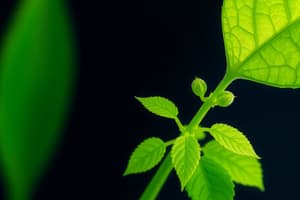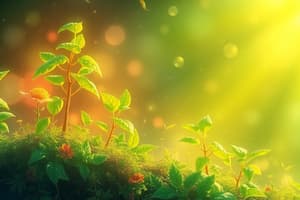Podcast
Questions and Answers
What is the role of RuBP in the Calvin Cycle?
What is the role of RuBP in the Calvin Cycle?
- RuBP combines with carbon dioxide to form a six-carbon molecule, which is then split into two 3-carbon molecules.
- RuBP helps transport electrons from Photosystem II to Photosystem I.
- RuBP is used to generate ATP and NADPH for the Calvin Cycle.
- RuBP is a five-carbon sugar that captures carbon dioxide from the atmosphere. (correct)
What is the main product of the Calvin Cycle that is used to produce glucose and other organic compounds?
What is the main product of the Calvin Cycle that is used to produce glucose and other organic compounds?
- ATP
- RuBP
- NADPH
- G3P (correct)
What is the role of ATP and NADPH in the Calvin Cycle?
What is the role of ATP and NADPH in the Calvin Cycle?
- They are used to regenerate RuBP.
- They provide the energy and reducing power necessary to convert carbon dioxide into sugar. (correct)
- They are used to split water and produce oxygen.
- They transport electrons from Photosystem II to Photosystem I.
What happens to the carbon dioxide molecules that enter the Calvin Cycle?
What happens to the carbon dioxide molecules that enter the Calvin Cycle?
How many molecules of G3P are produced for every six molecules of CO2 that enter the Calvin Cycle?
How many molecules of G3P are produced for every six molecules of CO2 that enter the Calvin Cycle?
What is the role of the enzyme Rubisco in the Calvin Cycle?
What is the role of the enzyme Rubisco in the Calvin Cycle?
Which of the following is NOT a product of the Calvin Cycle?
Which of the following is NOT a product of the Calvin Cycle?
What is the net gain of G3P molecules per turn of the Calvin Cycle?
What is the net gain of G3P molecules per turn of the Calvin Cycle?
What is the primary function of chlorophyll in photosynthesis?
What is the primary function of chlorophyll in photosynthesis?
In which part of the chloroplast does the Calvin cycle occur?
In which part of the chloroplast does the Calvin cycle occur?
What is produced as a result of the light reactions in photosynthesis?
What is produced as a result of the light reactions in photosynthesis?
Which of the following statements about photosynthesis is correct?
Which of the following statements about photosynthesis is correct?
Which components link the light reactions to the Calvin cycle in photosynthesis?
Which components link the light reactions to the Calvin cycle in photosynthesis?
What type of energy is sunlight classified as?
What type of energy is sunlight classified as?
In which part of the chloroplast do the light reactions take place?
In which part of the chloroplast do the light reactions take place?
What is the role of NADP+ in the light reactions?
What is the role of NADP+ in the light reactions?
What is formed when NADP+ is reduced during photosynthesis?
What is formed when NADP+ is reduced during photosynthesis?
Which of the following wavelengths of light are absorbed by chlorophyll?
Which of the following wavelengths of light are absorbed by chlorophyll?
Which process connects the two photosystems in the light reactions?
Which process connects the two photosystems in the light reactions?
What type of complex are the photosystems made of?
What type of complex are the photosystems made of?
What role does water play in Photosystem II?
What role does water play in Photosystem II?
Which process directly produces ATP during the light reactions?
Which process directly produces ATP during the light reactions?
What is constructed during the Calvin cycle?
What is constructed during the Calvin cycle?
Which compound is regenerated at the end of the Calvin cycle?
Which compound is regenerated at the end of the Calvin cycle?
In photophosphorylation, what drives the synthesis of ATP?
In photophosphorylation, what drives the synthesis of ATP?
Where do the light reactions of photosynthesis occur?
Where do the light reactions of photosynthesis occur?
What is the primary function of NADPH in photosynthesis?
What is the primary function of NADPH in photosynthesis?
Which step is NOT part of the Calvin cycle?
Which step is NOT part of the Calvin cycle?
Flashcards
Autotrophs
Autotrophs
Organisms that can produce their own food through photosynthesis.
Heterotrophs
Heterotrophs
Organisms that obtain energy by consuming other organisms or organic matter.
Photosynthesis
Photosynthesis
The process by which green plants and some other organisms use sunlight to synthesize foods with the help of chlorophyll.
Chlorophyll
Chlorophyll
Signup and view all the flashcards
Carbon Fixation
Carbon Fixation
Signup and view all the flashcards
What is Photosynthesis?
What is Photosynthesis?
Signup and view all the flashcards
What are light-dependent reactions?
What are light-dependent reactions?
Signup and view all the flashcards
What is the Calvin cycle?
What is the Calvin cycle?
Signup and view all the flashcards
What is chlorophyll?
What is chlorophyll?
Signup and view all the flashcards
What are photosystems?
What are photosystems?
Signup and view all the flashcards
What is the electron transport chain?
What is the electron transport chain?
Signup and view all the flashcards
What is ATP?
What is ATP?
Signup and view all the flashcards
What is NADPH?
What is NADPH?
Signup and view all the flashcards
What does Photosystem II do?
What does Photosystem II do?
Signup and view all the flashcards
What happens to the electrons released by Photosystem II?
What happens to the electrons released by Photosystem II?
Signup and view all the flashcards
How is the proton gradient created in the thylakoid?
How is the proton gradient created in the thylakoid?
Signup and view all the flashcards
How is ATP produced in photophosphorylation?
How is ATP produced in photophosphorylation?
Signup and view all the flashcards
What is the role of Photosystem I?
What is the role of Photosystem I?
Signup and view all the flashcards
What is the role of the Calvin cycle?
What is the role of the Calvin cycle?
Signup and view all the flashcards
What are the steps of the Calvin cycle?
What are the steps of the Calvin cycle?
Signup and view all the flashcards
Where does the Calvin cycle occur?
Where does the Calvin cycle occur?
Signup and view all the flashcards
What is carbon fixation?
What is carbon fixation?
Signup and view all the flashcards
What is Rubisco?
What is Rubisco?
Signup and view all the flashcards
What is RuBP?
What is RuBP?
Signup and view all the flashcards
What is reduction in the Calvin cycle?
What is reduction in the Calvin cycle?
Signup and view all the flashcards
What is regeneration of RuBP?
What is regeneration of RuBP?
Signup and view all the flashcards
Why does the Calvin cycle only release one G3P molecule per three CO2 molecules?
Why does the Calvin cycle only release one G3P molecule per three CO2 molecules?
Signup and view all the flashcards
What is the main product of the Calvin cycle?
What is the main product of the Calvin cycle?
Signup and view all the flashcards
What does the photosynthesis equation represent?
What does the photosynthesis equation represent?
Signup and view all the flashcards
Study Notes
Photosynthesis Overview
- Autotrophs produce their own food through photosynthesis.
- Heterotrophs consume plants or animals or decompose organic matter.
- Photosynthesis uses solar energy to transform carbon dioxide and water into sugar and other organic molecules.
Photosynthesis Equation
- 6CO₂ + 6H₂O + light energy → C₆H₁₂O₆ + 6O₂
- Carbon dioxide + water + light energy → glucose + oxygen
Photosynthesis Location
- Occurs in chloroplasts within plant cells.
- Chloroplasts have a double membrane, thylakoids (stacked structures), and stroma (fluid-filled space).
- Chlorophyll, a light-absorbing pigment in chloroplasts, converts solar energy to chemical energy.
Leaf Structure and Photosynthesis
- Mesophyll cells in leaves contain chloroplasts.
- Carbon dioxide enters and oxygen exits through stomata (pores).
- Chloroplast structure includes inner and outer membranes, grana (stacks of thylakoids), and stroma.
Tracing Photosynthesis with Isotopes
- Scientists used isotopes to trace the process.
Redox Reaction in Photosynthesis
- Photosynthesis is a redox process (oxidation-reduction).
- Water (H₂O) is oxidized, and carbon dioxide (CO₂) is reduced.
Photosynthesis Stages
- Occurs in two linked stages that use ATP and NADPH:
- Light reactions happen in thylakoid membranes and produce ATP and NADPH.
- Calvin cycle, in the stroma, uses ATP and NADPH to incorporate carbon dioxide into organic compounds (carbon fixation).
Light Reactions (Details)
- Light energizes electrons in chlorophyll.
- Electrons travel through the electron transport chain to produce ATP and NADPH.
- Water is split (oxidized) to replace lost electrons and O₂ is released.
- Photophosphorylation involves pumping H⁺ ions into the thylakoid space.
- The H⁺ gradient powers ATP synthesis via ATP synthase.
Calvin Cycle (Details)
- CO₂ is incorporated into RuBP (ribulose bisphosphate) via the enzyme Rubisco.
- G3P (glyceraldehyde-3-phosphate) is generated and the cycle regenerates RuBP.
- Using ATP, NADPH, and CO₂, the cycle creates G3P, forming sugars like glucose.
Visible Light and Pigments
- Sunlight is electromagnetic energy.
- Chlorophyll and other pigments absorb specific wavelengths of visible light.
- Chlorophyll reflects green light.
Photosystems
- Embedded in thylakoid membranes.
- Composed of light-harvesting complexes and a reaction center.
- Capture solar energy and transfer it to the reaction center.
- A primary electron acceptor captures electrons from the reaction-center chlorophyll.
Studying That Suits You
Use AI to generate personalized quizzes and flashcards to suit your learning preferences.




